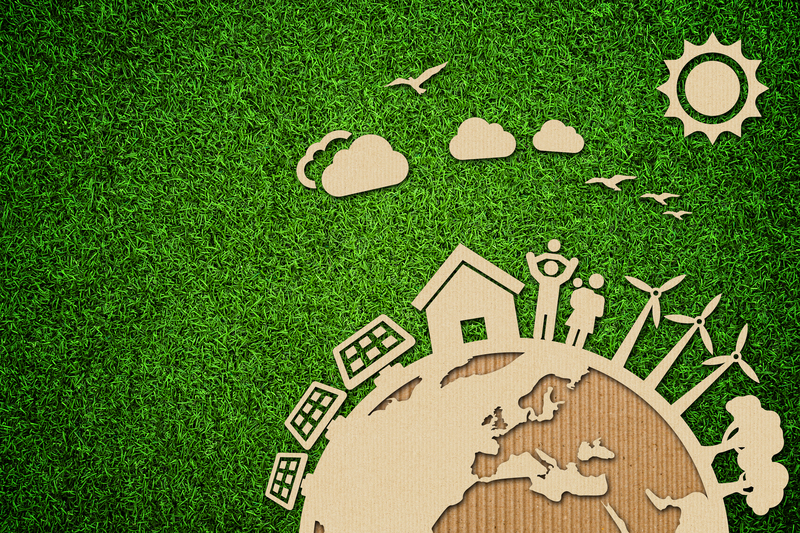Celebrate Green Living by Giving Trash a Second Chance through Upcycling
Green living is more than just a trend--it's a lifestyle that safeguards our planet. As the world faces mounting environmental challenges, embracing sustainable habits is crucial. One of the most creative and impactful approaches is to give trash a second chance--by turning what would be waste into valuable, beautiful, and functional items through upcycling. Discover how to embrace eco-friendly living, reduce your waste, and create a greener tomorrow by learning everything you need to know about upcycling.
What is Upcycling?
Upcycling is the art of transforming discarded, unused, or unwanted materials into new items of greater value or utility. Unlike recycling, which may involve breaking materials down, upcycling focuses on repurposing items and enhancing them, often through creative modifications.
- Recycling breaks items down to create raw materials for new products.
- Upcycling increases an object's worth by creatively reusing it without significant processing.
For instance, giving trash a second chance could involve turning old glass jars into stylish vases, upcycling wooden pallets into bespoke furniture, or transforming worn-out jeans into trendy tote bags.

Why Give Trash a Second Chance? The Benefits of Green Living and Upcycling
1. Environmental Benefits
- Reduces landfill waste: By upcycling, less waste ends up in overcrowded landfills, reducing pollution.
- Lowers carbon footprint: Upcycling requires less energy than producing new items, cutting down greenhouse gas emissions.
- Conserves raw materials: Every item repurposed saves raw materials and prevents habitat destruction from resource extraction.
2. Economic Advantages
- Saves money: Upcycling projects are often cost-effective alternatives to buying new products.
- Boosts local economies: Local artisans and small businesses thrive on upcycled goods.
3. Personal Satisfaction and Creativity
- Fosters creativity: Upcycling is a wonderful way to let your creative side shine as you transform everyday trash into treasures.
- Unique and personal touch: Upcycled items are often one-of-a-kind, reflecting your style and ingenuity.
Upcycling vs. Recycling: What's the Difference?
While both recycling and upcycling are essential to eco-friendly living, there are key distinctions:
- Recycling involves breaking down waste materials (like paper, glass, or plastic) to create new products, a process that often consumes significant energy and resources.
- Upcycling gives trash a second chance by directly reusing and enhancing existing materials--requiring less energy, generating unique results, and supporting sustainable living practices.
Popular Upcycling Ideas to Kick-Start Green Living
Ready to embrace a greener lifestyle? Here are some creative and practical upcycling ideas to try at home:
1. Furniture Makeovers
- Turn old wooden pallets into garden benches, coffee tables, or shelving units.
- Repaint and reupholster discarded chairs to create an eclectic, vintage look.
2. Creative Containers and Planters
- Transform glass jars and cans into candle holders, spice containers, or plant pots.
- Use plastic bottles as self-watering planters for herbs and flowers.
3. Textile Transformations
- Sew tattered T-shirts into quilts, tote bags, or cleaning rags.
- Repurpose old jeans as cushion covers or patchwork projects.
4. Upcycled Art and Decor
- Craft wall art from bottle caps, corks, and scrap metal.
- Create unique clocks or mirrors using bicycle wheels or old records.
5. Organizational Solutions
- Convert shoe boxes into stylish storage bins with just some fabric or paper covers.
- Refashion tin cans into desktop organizers or kitchen caddies.
Remember: The possibilities are only limited by your imagination. Giving trash a second chance doesn't just help the environment--it sparks original creations in every room of your home!
How to Start Your Upcycling Journey: Tips for Eco-Friendly Living
Getting started with upcycling doesn't require special skills or expensive tools. Here's a step-by-step guide to help you:
- Identify Materials: Scan your home for items that are no longer in use--furniture, containers, textiles, or packaging materials like cardboard and glass.
- Research Ideas: Draw inspiration from online platforms, upcycling blogs, and social media hashtags such as #upcycle or #secondchanceliving.
- Plan Your Project: Assess what tools, supplies, and techniques you'll need for each upcycling idea.
- Start Small: Choose simple projects as practice to build confidence--such as upcycling jars or revamping old picture frames.
- Share and Inspire: Once your creation is complete, share your results with friends and on social media to encourage others to embrace second-chance living.
Pro Tip: Involve family and friends in your upcycling projects as a fun, sustainable bonding activity!
Eco-Friendly Upcycling Projects for Every Room
In the Kitchen:
- Upcycle mason jars and bottles as spice racks, utensil holders, or soap dispensers.
- Convert an old ladder into a hanging pot rack.
For the Living Room:
- Repurpose wooden crates into side tables or bookshelves.
- Attach caster wheels and a cushion to an old trunk for a stylish ottoman.
In the Bedroom:
- Mount surplus drawers onto the wall for floating shelves.
- Transform broken jewelry into unique picture frame accents or wall hangings.
Bathroom Upcycles:
- Use tin cans as decorative planters or vanity organizers.
- Repurpose old towels into cleaning cloths or bath mats.
Garden and Outdoor Spaces
- Craft bird feeders from teacups or plastic bottles.
- Build garden beds or compost bins from reclaimed wood pallets.
Beyond the Home: Upcycling Communities and Businesses
Upcycling isn't just for individuals. A growing number of artists, small businesses, and non-profits are embracing upcycled products to promote sustainable living at scale. By supporting these enterprises, you help amplify the positive impact of giving trash a second chance.
- Local Artisan Markets: Browse upcycled jewelry, home decor, and furniture crafted by creative professionals.
- Eco-Friendly Brands: Many companies dedicate their mission to sustainable living and upcycled fashion--such as apparel made from repurposed textiles or bags created from recycled plastics.
- Workshops and Events: Attend community workshops on upcycling, zero-waste lifestyles, or green living fairs to meet like-minded individuals.
By participating in or supporting these initiatives, you directly contribute to a circular economy--where waste is minimized, and resources are maximized.
Overcoming Upcycling Challenges
While upcycling is fun and rewarding, there are a few challenges you might face:
- Access to Quality Materials: Not every piece of discarded material is suitable for upcycling. Be selective to ensure safety and durability.
- Time and Effort: Some projects require significant time or specialized skills, but there are always easy alternatives to try.
- Finding Inspiration: If you're stuck, turn to online tutorials or join eco-friendly forums for fresh ideas and community support.
Remember:
Upcycling isn't about perfection; it's about progress and creativity. Each item you rescue from the waste stream marks a positive step toward green living.
Tips for Making a Bigger Upcycling Impact
- Engage Your Community: Organize local upcycling drives, workshops, or swap events to encourage broader participation in sustainable living projects.
- Educate: Share upcycling knowledge in schools, social groups, and online spaces to inspire others.
- Support Upcycled Products: Choose goods made from upcycled materials whenever you shop, and recommend them to others.
Upcycling is infectious--one project can inspire many others. As more people join the movement, the positive effects multiply, creating cleaner, healthier communities.
The Role of Technology in Upcycling and Celebrating Green Living
Technology is revolutionizing the world of upcycling and green living. Here's how:
- Online Tutorials: Countless blogs, YouTube channels, and Instagram accounts showcase creative upcycling projects and DIY guides.
- Apps and Marketplaces: Digital platforms connect upcyclers with buyers and sellers, ensuring upcycled goods find appreciative homes.
- Sharing and Inspiration: Community forums help upcyclers exchange ideas, troubleshoot projects, and celebrate green living together.
Success Stories: Upcycling Changing the World
Across the globe, upcycling is making a real impact. In India, artisans craft stunning furniture from old boats and metal scraps. In Europe, designers turn used denim into high-fashion items. Meanwhile, American entrepreneurs are transforming single-use plastics into durable, reusable products. These success stories prove that giving trash a second chance is a viable, effective way to foster sustainability and creative entrepreneurship.

Conclusion: Join the Upcycling Movement for a Greener Future
Green living begins with small, everyday choices. When you give trash a second chance through upcycling, you're not just saving the planet-- you're reacting against wasteful habits, unleashing your creativity, and setting an example that others will follow. Whether you repaint a tired chair, craft decor from old jars, or support upcycled products, every action adds up.
The journey towards sustainable living is ongoing, and upcycling is one of the most accessible, rewarding, and impactful ways to take part. So, gather your "trash," unleash your imagination, and celebrate green living by giving everything a new, purposeful life.
Frequently Asked Questions about Upcycling and Green Living
What materials can I upcycle?
A wide variety of materials can be upcycled, including glass, metal, wood, textiles, plastics, and even paper. Use your creativity to see potential in everyday items!
Is upcycling expensive?
Most upcycling projects are affordable since you're repurposing materials you already have. Some might require minor investments in tools or decorative materials, but overall, it's a budget-friendly approach to sustainable living.
How does upcycling help the environment?
Upcycling minimizes landfill waste, reduces the need for new resources, conserves energy, and often prevents pollution associated with raw material extraction and waste incineration.
How can I find upcycling ideas?
Explore blogs, YouTube, Pinterest, and social media for endless upcycling inspiration. Join local workshops or online communities to share and gather creative ideas.
Can upcycling be profitable?
Absolutely! Many artisans and small businesses generate income through innovative upcycled products, selling them at markets or online platforms.
Are you ready to celebrate green living by giving trash a second chance? Start upcycling today and join the movement toward a cleaner, more sustainable world!